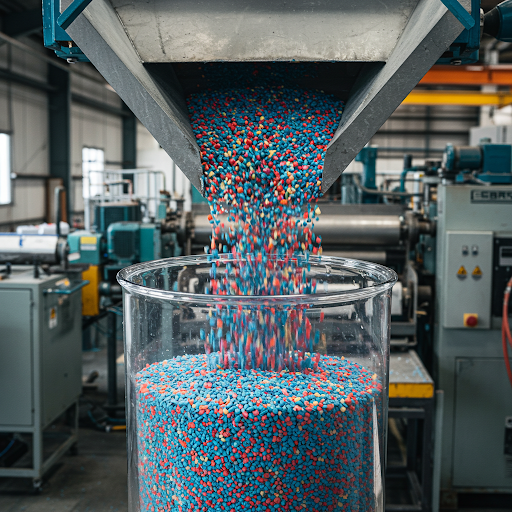Various types of additives are used in extrusion processes.
The most important additive groups used include:
Internal and external lubricants, nucleating agents, viscosity modifiers, heat stabilizers and antioxidants, impact modifiers, dyes and pigments, fillers, etc.
The selection depends on the type of plastic used, the desired properties of the final product, and the specifications of the extrusion line. The function of each additive and the effect of their use on the final product will not be discussed in detail here.
However, we would like to discuss in more detail the effects of their use on the efficiency of the plasticizing group, its productivity, and its wear.
________________________________________
The productivity of an extrusion line is essentially determined by:
• Screw flow rate (kg/h).
• Melting process efficiency (energy consumption, melt homogeneity).
• Flow stability (no deposits, thermal degradation, or viscosity changes).
• Barrel and screw wear (component lifespan and maintenance requirements).
The efficiency of the plasticizing group (screw and barrel) in plastics extrusion is strongly influenced by the additives used, as they alter the material’s rheology, melt temperature, flowability, and component wear.
Of course, additives can also have generally positive effects on plant productivity:
✅ Reduced extruder wear → Lower maintenance costs.
✅ Better polymer flow → Faster extrusion speed.
✅ Shorter cooling and stabilization times → Higher productivity.
✅ Better product quality → Less waste and greater process repeatability.
Indeed, the correct use of additives is crucial to ensuring production efficiency, product quality, and reducing operating costs.
Potential problems:
________________________________________
🔴 Mineral fillers and glass fibers, high-hardness fillers (talc, calcium carbonate)
• Highly abrasive materials accelerate screw wear and require the use of screws with resistant coatings (e.g., nitriding, tungsten carbide).
• They can also cause abrasion on the barrel walls, thus shortening their service life. Therefore, barrels coated with high-strength materials (bimetallic) are required.
• Mineral fillers and glass fibers can increase the bulk density of the material, requiring higher screw torque → higher energy consumption.
🔴 Heat stabilizers
• Some heat stabilizers can decompose at high temperatures and produce volatile byproducts that contaminate the extruder.
🔴 Chemical blowing agents
• Some expanding compounds release gases that can lead to pressure fluctuations in the barrel and cause instability.
🔴 Excess lubricant
• If incorrectly dosed, they can cause slippage problems in the barrel and reduce melt efficiency. Excessive amounts can cause a slip-stick effect with flow instability and pressure fluctuations in the barrel.
🔴 Pay attention to the dosage!
• Excessive use of some additives can reduce melt viscosity more than necessary, leading to process instability.
________________________________________
So, what strategies are there to optimize the productivity and service life of the plasticizing group?
To maximize extruder efficiency and avoid premature wear, the following strategies can be used:
1. Screw and barrel configuration – Viplas offers assistance and support for this.
• Screws with optimized profiles (barrier, mixing, venting) to improve melt homogeneity.
• Wear-resistant coatings (bimetallic, nitriding, tungsten carbide) to reduce the effects of abrasive loads.
• Monitor temperatures and pressures to avoid operating conditions that accelerate wear.
2. Optimal Additive Selection
• Balance the use of internal and external lubricants to ensure good gliding without excessive slippage.
• Use high-quality heat stabilizers to minimize polymer degradation.
• Limit the amount of abrasive loads or use resistant materials for the screw and barrel.
3. Temperature and Pressure Control
• Prevent overheating by precisely controlling the barrel heating zones.
• Avoid pressure fluctuations in the barrel that can result from incorrect additive dosing.
________________________________________
Conclusions
The use of suitable additives in the extrusion process has a significant impact on productivity.



